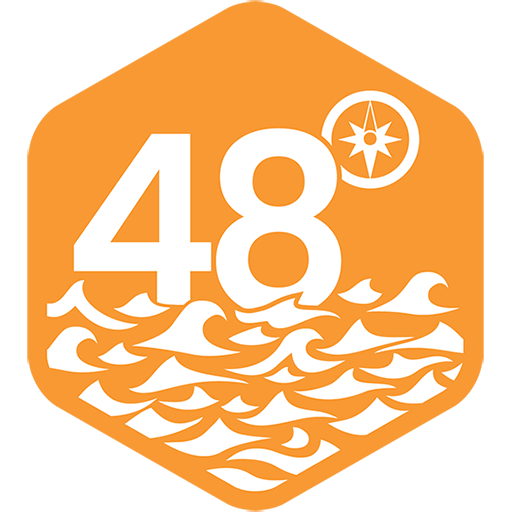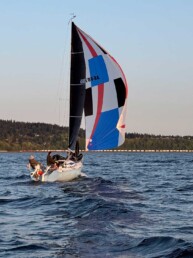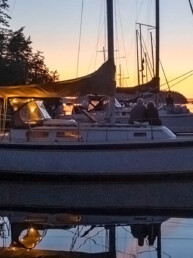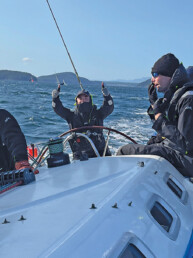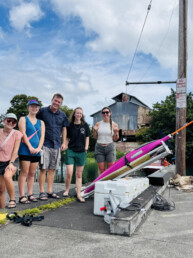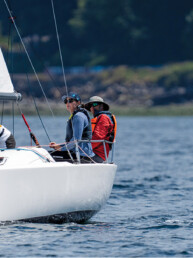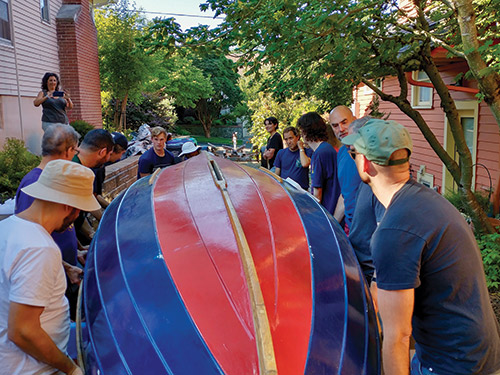
It was a beautiful Sunday morning in July, sunny with a high of 80 degrees predicted. Instead of doing something outside, I was deep in the throes of organizing for my next cruise, with packets of food, a stack of charts, and toilet paper heaped up in our guest room. Then came a text message from my friend Rory.
“Hey so boat flipping is on for 5 p.m. today. You’re welcome to come have a beer and supervise if you’re free!”
This was the only time I had to complete a huge list of my own boat projects before my summer cruise, and I imagined it would take me well into the evening hours. Wearily, I wrote back, “I’ll try to swing by. Packing for a big trip to the Gulf Islands and up to my eyeballs in tasks.”
Earlier in the month, Rory and I had talked about the best way to paint the bottom of his 18-foot wooden sail and oar boat. Should he do it on its trailer, or somewhere else? We debated the merits of sliding it off the trailer and onto some blocks, then using small jack stands to hold it upright, like a keelboat. Or maybe it would be better to assemble a crew of friends to lift and flip it upside down onto sawhorses? Rory argued for the flip, citing the efficiency and ultimate smoothness of the paint job if he could do it all at once, rather than having to paint around any kind of supports.
I couldn’t knock his line of reasoning, but every time I’ve flipped a boat, the days and hours leading up to the event have been plagued by persistent visions of the whole thing going wrong. In my head, I could almost hear the terrible crunching sound of wood and split planks as the crew accidentally dropped it. The inefficiency of moving a few jack stands around wouldn’t seem like a big deal to Rory if that happened. Still, he was steadfast.
As the day wore on, I realized that I needed a break from packing clothes, checking anchor rode for abrasions, and dealing with fiddly last minute things like touching up paint on my dinghy. And to be honest, I was concerned that Rory and his crew might need help. So that afternoon, after consulting with my wife over the readiness of our to-do list, I texted Rory, “I’m cleared for flipping!”
When I arrived at his driveway at 5 o’clock, only two other people were present. I estimated that we’d need a minimum of six adults to safely turn the boat, and even then I wasn’t sure, since none of us knew exactly how much it actually weighed.
The next people to arrive weren’t boaters and, while willing to help, they were highly skeptical about the probable success of our mission. “What if you put it in the river and use some underwater paint?” one man joked. “Or you could leave it on the trailer,” said another. “Then use mirrors and long-handled brushes to get the challenging parts, sort of like a dentist.” Another guy suggested that we slide the boat onto the ground, push it on one side, paint, then roll it the other way and repeat.
Before long we had six volunteers, then seven, but there was a funk of uncertainty in the air. Then, like a small navy anticipating reinforcements during a battle, our mood was buoyed by a rumor that “the teenagers” were coming. Cheered by the prospect of youthful brawn and enthusiasm, we awaited this development eagerly, although I privately wondered whether the energy of our prospective assistants might also be a liability when moving a wooden boat. While we waited, Rory regaled the crowd with the story of how he’d purchased the half-finished “dead man’s dream boat” from people dissolving an estate, then spent months restoring the interior (discussed in my column from the January 2023 issue). Painting the scuffed, peeling bottom and installing the centerboard would be among the last tasks before launching.
When the teenagers arrived, along with a few more neighbors, we seemed to have ample hands to complete the task. I stood back, watching to see how Rory would organize the team. Arms rested on the gunwales and excited, if uncertain, faces looked to him for direction.
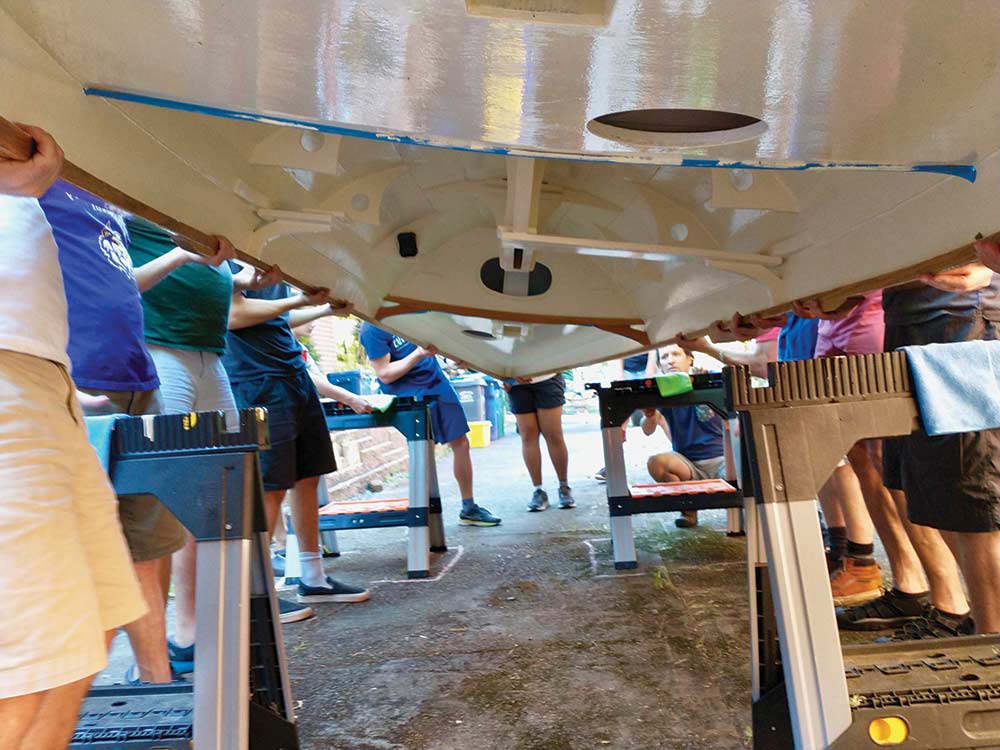
“Exactly how much does this thing weigh?” someone asked.
Ducking the question, Rory turned towards me. “Bruce has a boat like this. How many times have you flipped it?”
With all eyes upon me, I held up four fingers, suddenly nervous as I realized that Rory had been serious when he’d texted to ask that I lead the operation. Gingerly, I explained the logistics of the mission and then got input from the group about the best way to move the trailer after lifting the boat, and how to set it in just the right position to be well balanced and stable on the sawhorses.
The mood was tense, yet optimistic, as I explained the importance of the maneuver’s most critical moment, when one half of the group would be bearing most of the boat’s weight on their side of the gunwale, after the other half of the group had turned the craft vertically.
“What if it goes bad?” quipped a wise guy. “Do we have a safe word?” A dose of humor was just what was needed to relax the mood.
I assigned roles to individuals, and as a group we choreographed how each part of the flip would go. We pantomimed the actions once, and then we assembled around the boat for a test lift. Standing at the bow, I barely had to flex a muscle. Smiles broke out all around when we saw that no one had to strain to raise the boat a foot in the air. It was then that I knew we’d succeed, but I didn’t say a word. I simply directed the group according to the plan. Arms lifting, bodies shifting, the boat rose. People moved gracefully, gently turning and then lowering the boat, until it sat on the sawhorses, exactly where we’d intended.
“Woop woop!” the group cheered, stoked from the collective effort and relieved that it had gone so well.
“It was like a barn raising,” someone said.
“How did they do that in the old days?” another wondered aloud.
“We should do stuff like this at a block party!” exclaimed a third, clearly inspired by our accomplishment.

I’ve participated in similar events over the years, ranging from a more complicated turn using ropes, to one where we pulled a completed boat through a window from a basement workshop. The result was always the same, both for the participants and the boat owner: elation. Maybe we hadn’t done anything that old salts couldn’t have accomplished more quickly with a block and tackle; but in an age when so many of our achievements are performed electronically, the physical turning of an 18-foot boat was something to be proud of. We’d come together for an afternoon to help carry out a dream, and we’d succeeded.
Bruce Bateau sails and rows traditional boats with a modern twist in Portland, Oregon. His stories and adventures can be found at www.terrapintales.wordpress.com.
Bruce Bateau
Bruce Bateau sails and rows traditional boats with a modern twist in Portland, Ore. His stories and adventures can be found at www.terrapintales.wordpress.com
